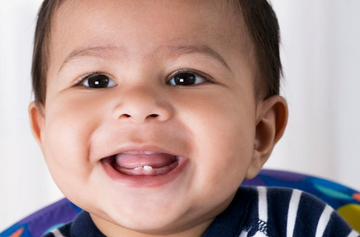If there’s drool constantly hanging from your baby’s chin and she is suddenly wanting to put everything in her mouth, her first tooth is probably on its way.
While you might be focused on easing her gum pain and keeping her as comfortable as possible while she’s teething, it’s also important to start thinking about taking care of those little pearls.
Here’s why: If a baby has teeth, those teeth can get decay and cavities. And children with cavities in their baby teeth are more likely to get cavities in their permanent teeth. So it’s important to start a dental care routine early, says pediatric dentist Trista Onesti, DDS.
How do you go about doing that? Dr. Onesti has some pointers.
Oral Care for Infants
It’s important to know that one of the reasons that some children are more prone to developing cavities is because of a bacteria called Streptococcus mutans. It’s the main culprit behind tooth decay, because it feeds on sugar and creates acid that dissolves the protective enamel on the teeth.
Babies aren’t born with this bacteria, but studies have shown that they can acquire it early on through the saliva of a parent or caregiver.
“If you’re kissing a baby on the lips, or sharing a spoon or using your mouth to clean off her pacifier, that can cause a child to acquire Streptococcus mutans,” Dr. Onesti explains.
And the more cavity-causing bacteria in the adult’s mouth, the more cavity-causing bacteria baby is going to get.
“We encourage parents or any other adults not to use their mouth to clean off a pacifier or share eating utensils or a toothbrush,” Dr. Onesti says.
Feeding habits can contribute to the health of a baby’s teeth, too. Babies who fall asleep with a bottle full of milk or juice in their mouth, or with a pacifier that’s been dipped in honey or sugar, may be at risk for baby bottle tooth decay. This happens when sugar collects around their teeth while they’re sleeping and feeds Streptococcus mutans bacteria, resulting in decay.
Oral hygiene also plays a role at this age. Once a baby’s first tooth comes in, it’s time to start brushing it. Use a small, soft toothbrush with a tiny smear of toothpaste on it – the American Dental Association recommends a dallop about the size of a grain of rice until age 3 – and gently brush all around the teeth.
Use a small, soft toothbrush with a tiny smear of toothpaste on it – the American Dental Association recommends a dallop about the size of a grain of rice until age 3 – and gently brush all around the teeth.
The fluoride in toothpaste will help strengthen the enamel on the teeth, so that they’re able to resist decay.
“When children are young and can’t spit, if you’re using toothpaste with fluoride in it, you want to wipe out the excess toothpaste with a piece of wet gauze,” Dr. Onesti says.
The fluoride isn’t harmful to their health, but when developing teeth get too much of it, they can take on a chalky white appearance known as dental fluorosis.
Children should also start visiting the dentist by either their first birthday, or six months after their first tooth erupts.
Toothbrushing for Toddlers
Until your little one develops the skills to brush his own teeth, you’ll need to lead the charge.
For young toddlers, Dr. Onesti recommends sitting cross-legged and having the child lay in your lap looking up at you. This gives you good access to the back of the teeth.
If your toddler isn’t cooperative, giving them something to play with or watch can be a good distraction.
At this point, you should be brushing twice a day and clearing excess toothpaste with a piece of gauze until the child learns to spit.
Preschool and Beyond
Once a child can spit, you can start putting a slightly bigger, pea-sized dallop of toothpaste on the toothbrush. Children ages 3 and older should brush twice a day for two minutes each time.
And don’t forget about flossing.
“As soon as they have teeth that are in contact with one another — it’s usually the molars in the back, and for most kids they come in around age 3 to 4 – the parent needs to be actively flossing a child’s teeth,” Dr. Onesti says.
You should continue to supervise your child’s dental routine until age 8. Before that age, they may not have the manual dexterity needed to reach all of the areas of the mouth.
If your child is still sucking their thumb beyond age 3, the American Academy of Pediatric Dentistry recommends talking to your pediatric dentist about it, as it could lead to crooked teeth or bite problems.
The American Dental Association also recommends replacing a toothbrush every three to four months and making regular visits to the dentist.
Developing good oral care habits as soon as that first tooth sprouts can help keep your kid cavity free and set the stage for a lifelong healthy smile.





